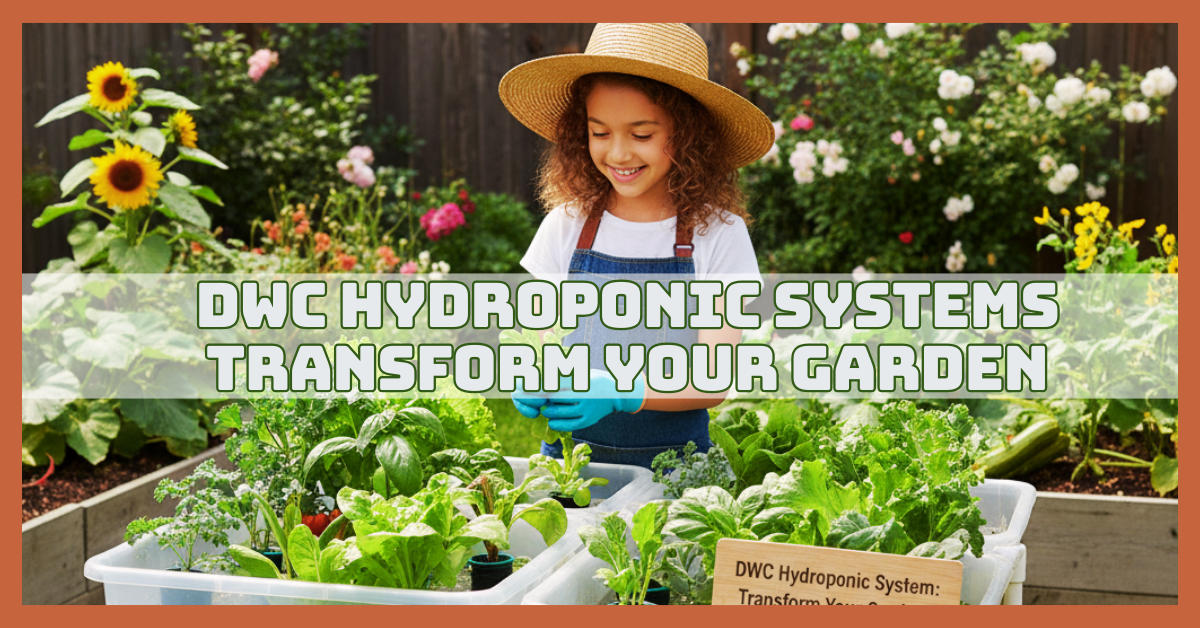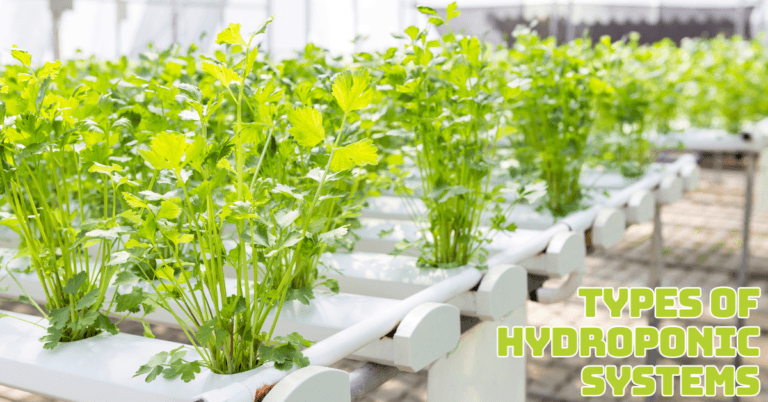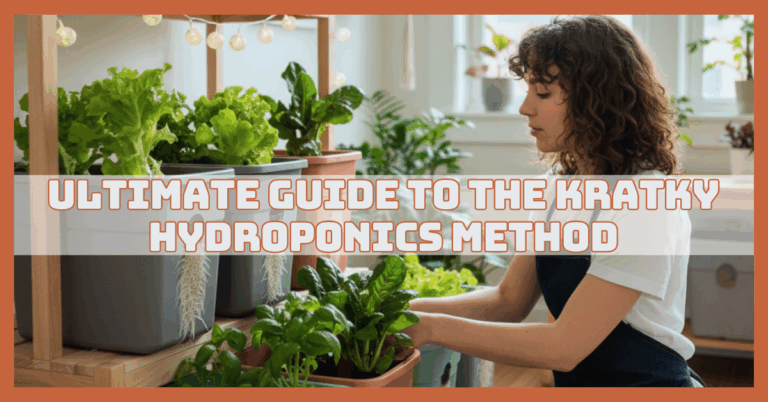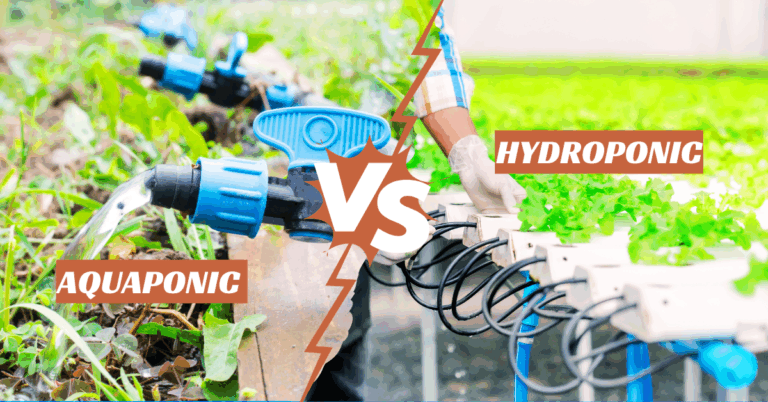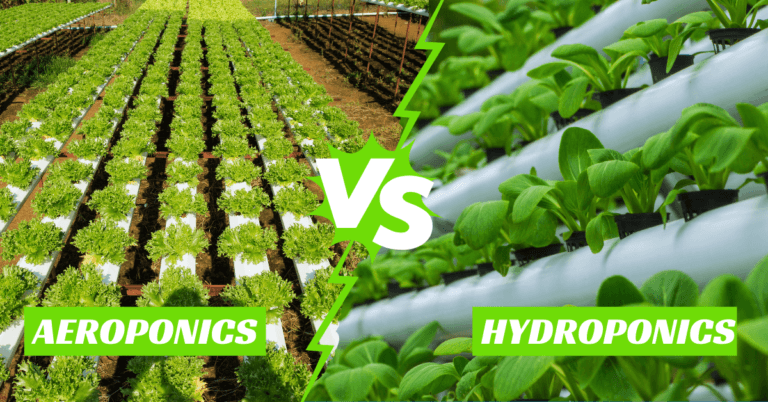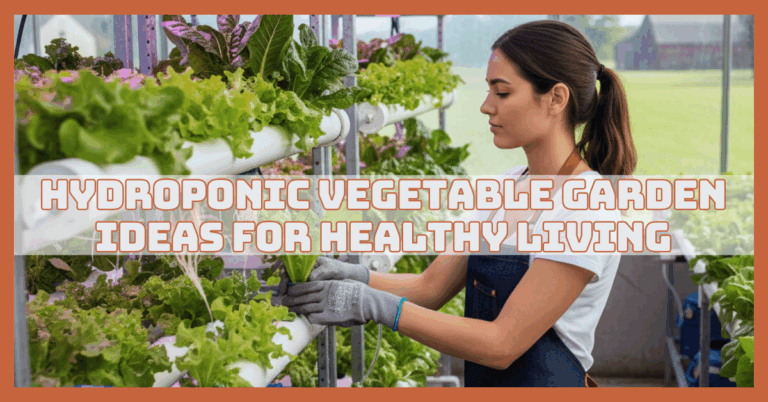DWC Hydroponic Systems: Transform Your Garden
Growing food at home is easier than ever with modern hydroponic methods. Among these, the DWC Hydroponic Systems stand out for their simplicity and impressive results.
By providing plant roots with direct access to oxygen and nutrient-rich water, it promotes faster growth and healthier harvests.
This method is beginner-friendly yet powerful enough for advanced growers, making it an excellent choice for anyone looking to maximize their gardening success indoors or outdoors.
What Are DWC Hydroponic Systems?
Deep Water Culture (DWC) hydroponic systems are a popular and beginner-friendly method of soilless cultivation. In DWC, plants grow with their roots fully suspended in a nutrient-rich water solution.
To guarantee that roots receive enough oxygen for proper growth, the water is continuously oxygenated by an air pump and air stones.
This constant access to nutrients and oxygen accelerates plant development compared to traditional soil growing. DWC systems are versatile and can be set up indoors, in greenhouses, or even in small urban spaces.
They are particularly suitable for fast-growing leafy greens, herbs, and small fruiting crops. A typical DWC setup includes a reservoir for the nutrient solution, net pots to hold seedlings, and an air pump to maintain dissolved oxygen in the water.
Water temperature, pH, and nutrient levels are carefully monitored to ensure optimal growth. The simplicity of DWC makes it cost-effective and low-maintenance for hobbyists while also being scalable for commercial use.
Variations include standard DWC, recirculating DWC, bubbleponics, vertical, hybrid, and automated systems, each offering different levels of complexity, space efficiency, and yield potential.
Overall, DWC hydroponics is an efficient, sustainable, and high-yielding growing method that supports year-round production without soil.
Types Of DWC Hydroponic Systems
1. Standard DWC System
The standard DWC system is efficient and straightforward. It performs best in moderate climates, 60–80°F, and can be set up indoors or outdoors with temperature control. Small systems cost $150–$300, while larger DIY or semi-commercial setups may reach $700.
Setup Process
To set up a standard DWC system, start with a reservoir or container that holds the nutrient solution, ideally opaque to prevent algae growth. Install an air pump connected to air stones to provide constant oxygenation.
Cut holes in a lid to hold net pots and fill them with a growing medium such as hydroton or rockwool cubes. Place seedlings in the net pots, ensuring roots reach the nutrient solution.
Adjust and stabilize pH (5.5–6.5) and maintain EC at recommended levels. Position the system in an area with consistent temperature control for steady plant growth.
Growing Process
Begin by filling a clean reservoir with a properly mixed nutrient solution and installing an air pump connected to air stones to ensure constant oxygenation for the roots.
Place seedlings in net pots filled with hydroton or rockwool, suspending their roots directly in the nutrient solution. Check and adjust pH daily, maintaining it between 5.5 and 6.5, and monitor EC to keep nutrient levels within recommended ranges.
Maintain water temperature at 65–75°F for optimal growth. Inspect roots regularly for health and signs of disease. Leafy greens like lettuce, spinach, and basil mature in 30–45 days. Continuously start new batches for uninterrupted production.
Best Crops
Lettuce, spinach, basil, cilantro, arugula, kale, mint
Pros
Standard DWC systems are easy to build, low-cost, and beginner-friendly. They allow rapid plant growth, save water, and reduce nutrient waste.
Maintenance is minimal, and leafy greens thrive. The setup is flexible and scalable, allowing growers to expand as they gain experience.
Cons
The system relies on electricity to power air pumps. Pump failure can quickly stress plants. It is not suitable for heavy-rooted or large fruiting crops.
Water temperature fluctuations can affect growth. Regular monitoring of pH and nutrients is necessary to avoid nutrient deficiencies.

2. Recirculating DWC System
A DWC hydroponic system with recirculating tanks continuously circulates nutrient solution, supporting multiple crops and ensuring consistent growth.
They work best in moderate to warm climates, 65–80°F. Costs range from $500–$2,000, depending on size and automation.
Setup Process
For a recirculating DWC system, arrange multiple plant sites connected to a central reservoir using PVC pipes or tubing. Install a submersible water pump to circulate nutrient solution throughout the system, while air stones provide oxygenation in each tank.
Secure net pots filled with hydroton or rockwool in holes cut into system lids. Place seedlings into net pots, letting roots extend into the solution.
Ensure tubing connections are leak-free and allow proper water return flow. Install valves for easy drainage and maintenance. Adjust pH, EC, and water temperature (65–75°F). Regularly sterilize tanks to prevent algae or pathogen buildup.
Growing Process
To grow in a recirculating DWC system, set up interconnected tanks with a central reservoir and submersible pump to circulate the nutrient-rich solution.
Maintain water temperatures between 65–75°F and oxygenate with air stones to keep roots healthy. Adjust pH to 5.5–6.5 for optimal nutrient uptake.
Begin with seedlings in net pots filled with clay pebbles or rockwool cubes. Ensure consistent monitoring of EC, pH, and water levels, topping up the solution as needed.
Regularly clean and sterilize the system to prevent algae and disease spread. With proper care, plants proliferate and produce high yields.
Best Crops
Lettuce, basil, arugula, spinach, cilantro, strawberries
Pros
Recirculating DWC systems improve nutrient efficiency and reduce water waste. They allow multiple plants or crops to share the same solution.
The system is scalable, supports continuous production, and ensures consistent growth. Oxygenation keeps roots healthy, and crops proliferate.
Cons
The biggest drawback is dependency on the pump—if it fails, all plants are at risk. The setup is more complex and costly compared to a simple DWC.
Water quality must be monitored closely, as algae, root rot, or disease can spread rapidly throughout the shared reservoir.

3. Bubbleponics DWC System
A DWC hydroponic system using the Bubbleponics method combines deep water culture with drip-fed nutrients to accelerate early plant growth efficiently.
Seedlings are drip-fed nutrients for faster early growth. Ideal for controlled climates 65–80°F, it costs $300–$1,500 depending on size.
Setup Process
To set up a Bubbleponics system, prepare a reservoir with nutrient solution and install air stones for continuous oxygenation. Add a small submersible pump connected with tubing to drip-feed nutrients directly to seedlings placed in net pots.
Secure net pots in the reservoir lid and fill them with hydroton or rockwool. Start seedlings in cubes and insert them so roots are near the drip emitters.
Set the pump on a timer for steady nutrient delivery until roots grow into the reservoir. Adjust pH (5.5–6.5), monitor EC, and keep water temperature between 65–75°F for optimal growth.
Growing Process
Begin by filling the reservoir with a well-balanced nutrient solution and installing air stones to oxygenate the water continuously.
Place seedlings in net pots suspended above the reservoir, ensuring roots can grow freely into the oxygen-rich solution.
Use a small submersible pump and tubing to drip nutrient solution directly to the base of seedlings during early growth, promoting faster development.
Monitor pH daily, keeping it around 5.5–6.5, and check EC to ensure proper nutrient strength. Maintain water temperature between 65–75°F.
Regularly check roots for rot or nutrient deficiencies. Leafy greens reach maturity in 30–40 days, while herbs may take slightly longer.
Best Crops
Lettuce, basil, spinach, mint, arugula, small herbs
Pros
Bubbleponics accelerates early growth and improves yields. It is more efficient than standard DWC alone. Roots receive continuous oxygenation and nutrients. It supports high-density growing and is compatible with both leafy greens and small fruiting crops.
Cons
Bubbleponics requires more equipment, such as pumps, tubing, and timers. Maintenance is higher, and setup is slightly more complex.
Electrical dependence is critical, and system failure can impact early-stage seedlings. Careful monitoring of nutrient levels is required.
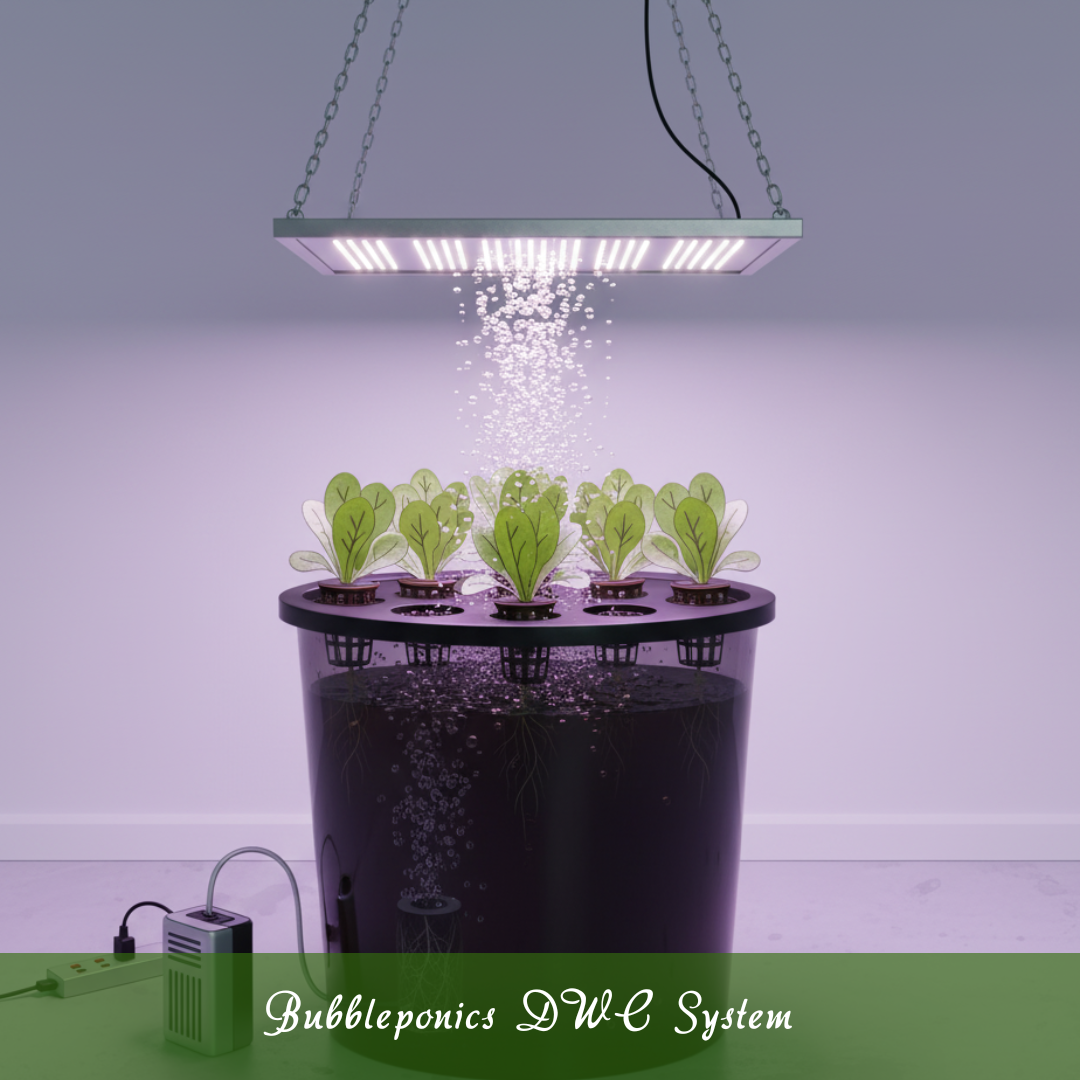
4. Automated DWC System
Automated DWC systems integrate sensors, timers, and pumps for precision farming. They are ideal for controlled climates, 65–80°F, in urban or commercial settings. Costs range from $1,500–$5,000, depending on automation, making them suitable for serious growers.
Setup Process
An automated DWC system setup begins with large reservoirs or interconnected tanks fitted with air stones and pumps.
Integrate sensors for pH, EC, and water temperature, connected to a central controller or timer system. Install automated dosing pumps to regulate nutrient and pH levels.
Place net pots in custom lids with seedlings in hydroton or rockwool, ensuring roots reach oxygenated water. Connect temperature control devices like water chillers or heaters for stability.
Calibrate sensors before use and sync them to monitoring software or mobile apps. Regularly test sensors for accuracy while maintaining a sterile and clean growing environment.
Growing Process
Install DWC tanks with automated nutrient dosing, pH monitoring, and air pumps. Seedlings are placed in net pots, roots suspended in oxygenated water. Sensors control nutrient delivery, water temperature, and oxygenation.
Daily checks verify sensor accuracy—clean tanks weekly to prevent algae. It takes 30 to 50 days to harvest leafy greens and herbs, and controlled cycles allow for constant, high-yield development.
Best Crops
Lettuce, spinach, basil, cilantro, arugula, mint, strawberries
Pros
Automation in DWC systems significantly reduces labour by handling nutrient dosing, pH adjustment, and oxygenation automatically. It ensures consistent water temperature and nutrient levels, minimizing human error.
Continuous monitoring supports higher yields and steady production cycles. The system efficiently cultivates leafy greens, herbs, and small fruiting plants, even in urban or commercial settings.
Cons
Automated DWC systems require a high initial investment and technical knowledge to operate effectively. Dependence on electronics makes the system vulnerable to power outages or sensor failures.
Maintenance and repairs can be costly, and regular monitoring of pumps, sensors, and tanks is essential to prevent system disruptions, plant stress, or potential crop loss.
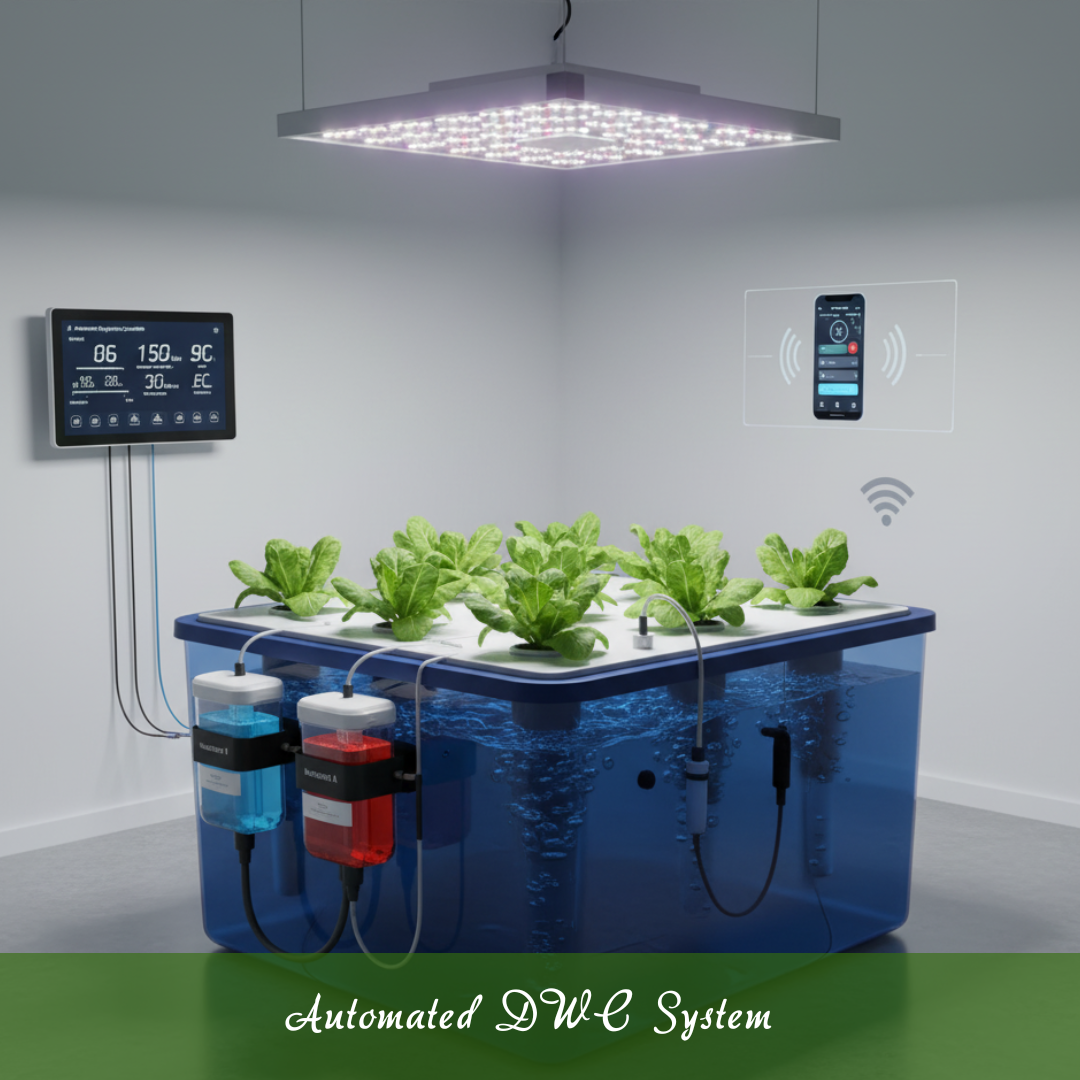
5. Kratky DWC System
The Kratky method is a simplified, passive DWC system that doesn’t require pumps or electricity. It works best in moderate climates between 60 and 80°F, indoors or in small greenhouses.
Costs are extremely low, ranging from $50 to $200, making it perfect for hobbyists or beginner growers looking for a no-fuss hydroponic system.
Setup Process
To set up a Kratky system, choose an opaque container or bucket to prevent algae growth. Fill it with a pre-mixed nutrient solution, leaving several inches at the top to accommodate root growth and create an air gap.
Place seedlings in net pots, floating collars, or foam inserts so roots hang freely in the solution. No pumps or electricity are required. Ensure the container is stable and positioned in moderate temperatures (60–80°F) with adequate light.
Monitor solution levels periodically to ensure roots remain submerged while gradually exposing them to air for oxygen as the plant grows.
Growing Process
To start, fill a clean container or reservoir with a balanced nutrient solution, maintaining a pH level between 5.5 and 6.5. Leave a few inches of space at the top to allow for oxygen exposure and root expansion.
Insert seedlings into net pots or floating collars so that their roots are submerged. As plants grow, the water level naturally decreases, creating an essential air gap that supplies oxygen to the roots.
Check nutrient strength and pH weekly. Ideal for fast-growing greens like lettuce, spinach, and arugula, which mature in 30–50 days. Harvest mature leaves and replant for a continuous cycle.
Best Crops
Lettuce, spinach, arugula, basil, cilantro, kale, mint
Pros
The Kratky method is simple, low-cost, and beginner-friendly. No electricity or moving parts are needed. Maintenance is minimal, and it conserves water and nutrients.
Leafy greens grow steadily, and the system allows for easy monitoring. It’s ideal for small spaces, educational purposes, or DIY setups with limited resources.
Cons
Because the system is passive, growth is slower than in aerated DWC setups. It’s unsuitable for large or fast-growing crops.
Oxygen levels are limited, and nutrient concentration must be monitored carefully. The system is less scalable and cannot support continuous production without frequent adjustments.
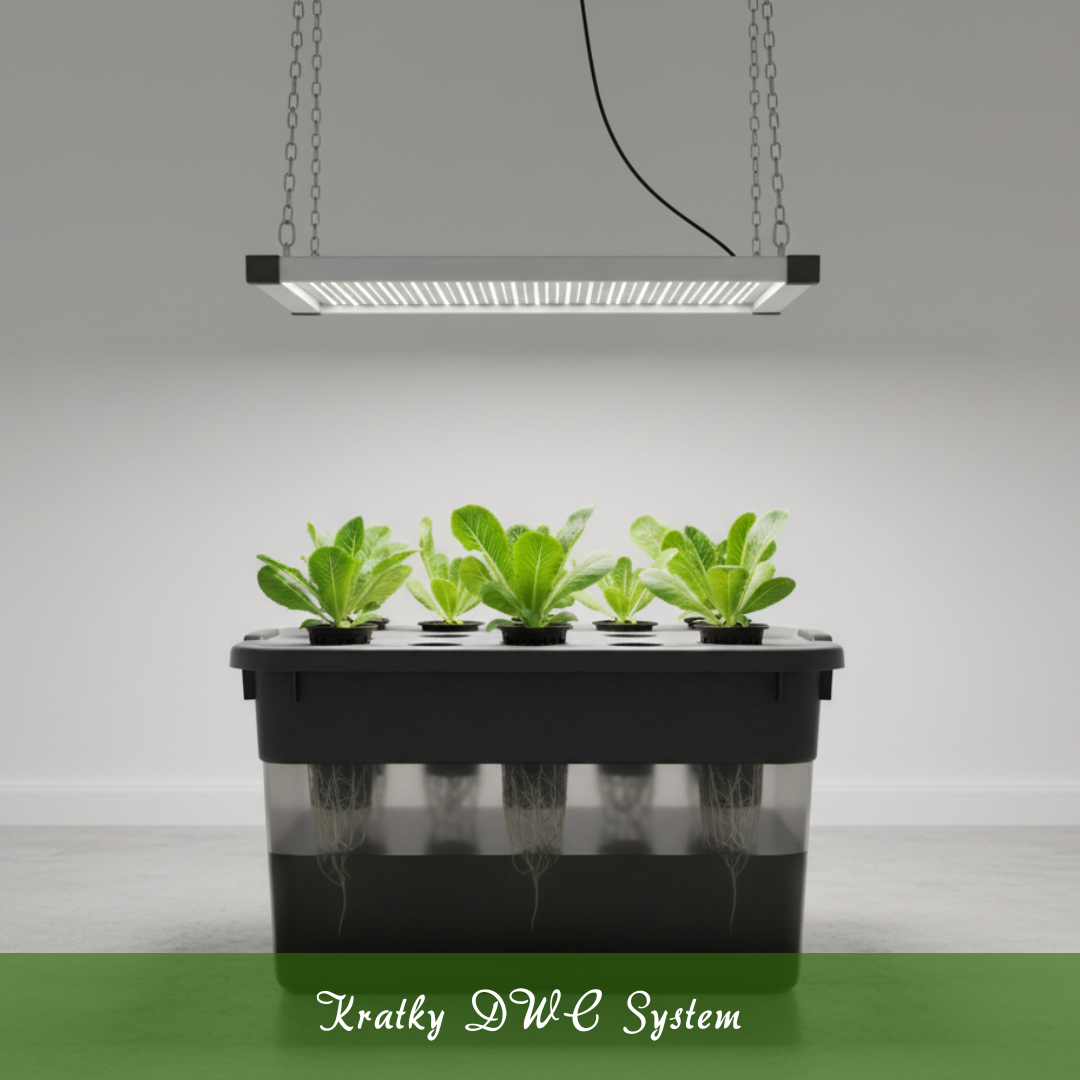
6. Multi-Tank DWC System
The multi-tank DWC system connects multiple reservoirs in series or parallel, allowing growers to expand production and manage crops at different growth stages.
It works best in moderate climates, 65–80°F, or controlled indoor environments. Costs range from $600 to $3,000, depending on the number of tanks and system complexity, making it ideal for small commercial setups or serious hobbyists.
Setup Process
Start by arranging multiple reservoirs in series or parallel, connecting them with food-safe tubing. Install a central submersible pump to circulate nutrient solution between tanks.
Add air stones in each reservoir for continuous oxygenation. Cut holes in lids to secure net pots filled with hydroton or rockwool, and place seedlings so roots reach the nutrient solution.
Ensure water flows evenly to all tanks, using valves to balance pressure and prevent overflows. Calibrate pH and EC sensors if installed, and set up a schedule for cleaning and maintenance. Monitor each tank regularly for consistent nutrient and oxygen levels.
Turn Your Passion for Nature Into Income
🌿 Whether you love gardening, caring for animals, or exploring holistic living,
You can share your knowledge online and earn from it.
Discover how nature lovers are growing their passions into meaningful, income-generating blogs. 👇
Growing Process
Begin by setting up multiple reservoirs connected with tubing and a central pump to circulate nutrient solution efficiently. Add air stones to each tank to maintain proper oxygenation.
Place seedlings in net pots, ensuring roots are fully suspended in the oxygen-rich solution. Monitor pH and electrical conductivity (EC) daily to maintain optimal nutrient balance—clean reservoirs weekly to prevent algae buildup and blockages in the tubing.
For continuous production, introduce new seedlings as older crops mature. Leafy greens and herbs typically reach harvest readiness in 30–50 days, allowing a steady rotation of fresh produce.
Best Crops
Lettuce, spinach, basil, cilantro, arugula, kale, mint
Pros
Multi-tank DWC systems are highly scalable, allowing multiple crops or growth stages to be grown simultaneously. Nutrient use is efficient, and oxygenation keeps roots healthy.
Continuous harvesting is possible, and plants grow uniformly. The system maximizes space utilization and supports faster production cycles, making it suitable for both hobby and commercial growers.
Cons
Pump or nutrient solution failure can affect all connected tanks. Maintenance is more complex than a single-tank setup. Costs are higher, and setup requires careful planning to avoid flow imbalance. Regular monitoring is essential to prevent algae growth, nutrient deficiency, or disease spread between tanks.

7. Vertical DWC System
A DWC hydroponic system with a vertical design maximizes space by stacking reservoirs, making it ideal for urban farms and indoor growing. It is perfect for urban farms, miniature greenhouses, or indoor setups where floor space is limited.
This system works best in moderate climates, 65–80°F, with controlled temperature and lighting. Depending on the size of the reservoir and the number of levels, prices might range from $700 to $4,000.
Setup Process
Begin by stacking multiple reservoirs or channels vertically, securing them to a stable frame. Connect each tier with tubing to a central submersible pump that circulates nutrient solution evenly.
Install air stones in every tier for root oxygenation. Cut holes in lids for net pots, and fill them with hydroton or rockwool. Place seedlings so that roots extend into the nutrient solution. Ensure water reaches all levels, adjusting flow rates as needed.
Position the system in an area with controlled temperature, humidity, and lighting. Regularly check pH, EC, and water temperature. Provide accessibility for harvesting and maintenance across all tiers.
Growing Process
Stack multiple reservoirs or channels vertically and connect them with tubing and a central pump. Install air stones in each tier to maintain oxygen levels.
Seedlings are placed in net pots with roots suspended in a nutrient solution. Ensure water and nutrient flow reaches each tier evenly. Monitor pH, EC, and water temperature daily.
Leafy greens and herbs mature in 30–50 days. Harvest from upper and lower levels sequentially, and add new seedlings to maintain continuous production.
Best Crops
Lettuce, spinach, basil, arugula, cilantro, kale, mint
Pros
Vertical DWC systems maximize space efficiency and allow higher yields per square foot. Oxygenation and nutrient delivery remain consistent across stacked levels.
They are scalable, support continuous production, and are ideal for leafy greens and herbs. The design enables easy monitoring and harvesting, making it an excellent choice for urban growers.
Cons
Lighting and nutrient flow must be carefully balanced across tiers. Pump or power failures can impact multiple aspects of the setup. The setup is more complex, and the initial costs are higher than standard DWC.
Regular cleaning is required to prevent algae, nutrient buildup, or disease. Maintenance can be challenging in taller setups.

8. Hybrid DWC System
The hybrid DWC system combines deep water culture with other hydroponic methods, such as NFT or drip systems. This allows growers to cultivate a wider variety of crops, including leafy greens and small fruiting plants. It works best in moderate climates, 65–80°F, or controlled indoor farms.
It is affordable for both serious enthusiasts and commercial producers, with prices ranging from $1,000 to $5,000, depending on the system's size and complexity.
Setup Process
Set up DWC reservoirs alongside NFT or drip channels according to crop type and available space. Install submersible pumps to circulate nutrient solution through all sections, ensuring steady flow.
Place air stones in each DWC reservoir to oxygenate roots. Seedlings start in rockwool, clay pebbles, or net pots and are inserted into the appropriate system: DWC for leafy greens, NFT/drip for fruiting crops.
Ensure tubing connections are secure, with proper flow rates to each section. Position the system in a temperature-controlled environment. Calibrate pH and EC sensors if available, and schedule regular cleaning to prevent blockages or algae buildup.
Growing Process
Set up DWC reservoirs alongside NFT or drip channels according to crop type. Seedlings are started in rockwool, clay pebbles, or net pots. Leafy greens are grown in the DWC section, while small fruiting crops receive drip-fed nutrients.
Oxygenate all reservoirs using air stones, and ensure continuous nutrient flow. Monitor pH and EC daily. Clean all reservoirs and channels weekly to prevent algae and blockages.
Leafy greens mature in 30–45 days, while small fruiting crops take 50–70 days. Continuous planting cycles maximize yield and crop diversity.
Best Crops
Lettuce, spinach, basil, arugula, strawberries, mint, cilantro
Pros
Hybrid DWC systems are versatile, allowing multiple crop types in one setup. Nutrient delivery is efficient, and oxygenation ensures healthy roots. They maximize space and yield, supporting both leafy greens and small fruiting plants.
Continuous production is possible, and growers can experiment with crop combinations. The system is ideal for commercial or semi-commercial operations.
Cons
Hybrid systems are more complex and require technical knowledge. Maintenance is higher due to multiple components. Initial costs are significant.
Pump or system failure can affect various crops. Monitoring nutrient levels and pH is essential to prevent deficiencies or imbalances.
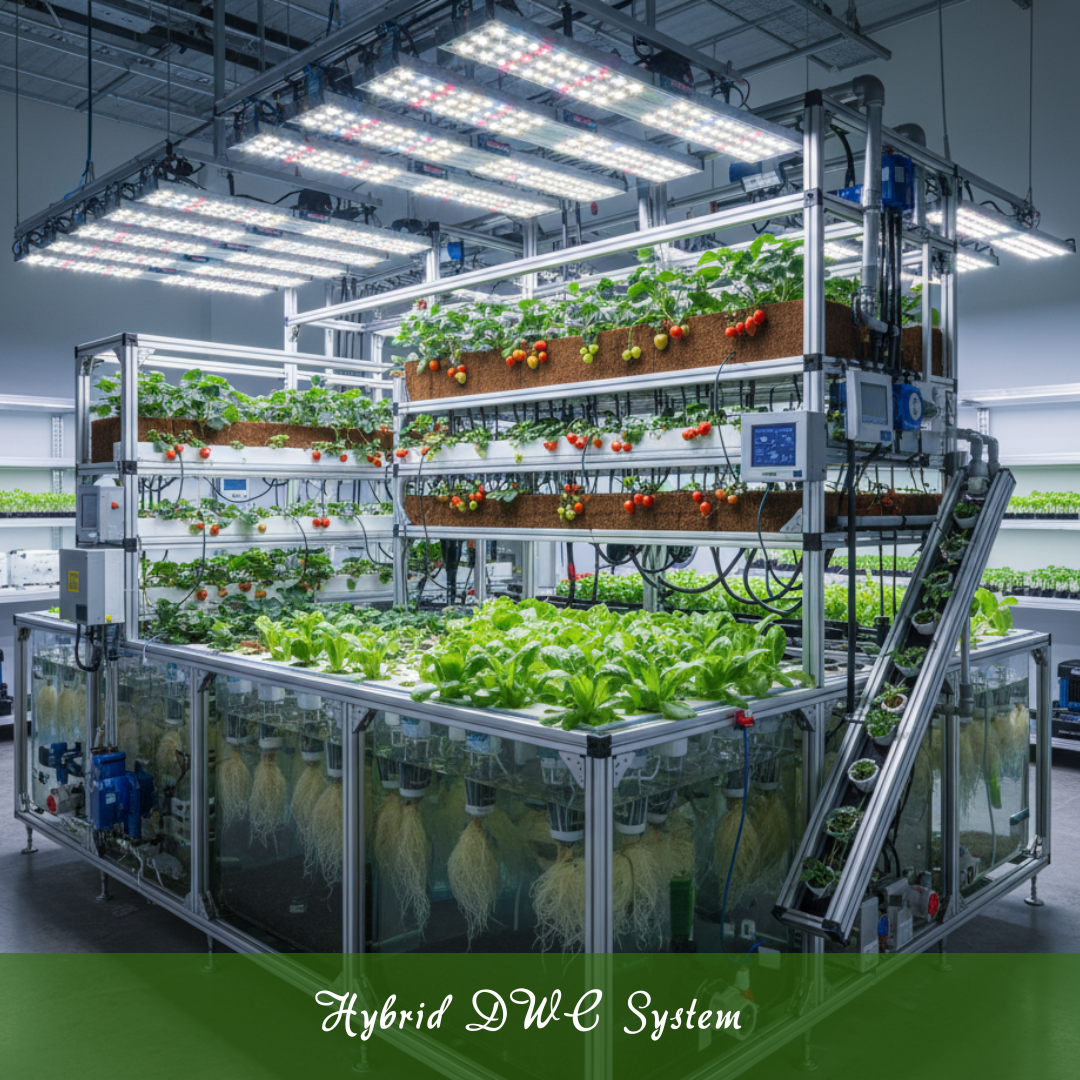
9. Automated Vertical DWC System
A DWC hydroponic system with automated vertical stacking uses sensors and pumps to precisely control nutrients, oxygen, and water for high-yield urban or commercial farms.
Sensors, timers, and pumps control nutrient dosing, oxygenation, and water levels. It works best in controlled climates, 65–80°F, ideal for urban farms or commercial operations with limited space. The price varies from $3,000 to $10,000 based on the number of levels and automation degree.
Setup Process
Begin by stacking multiple reservoirs or channels vertically, securing them to a stable frame suitable for automated systems. Connect each tier with tubing and submersible pumps to circulate nutrient solution evenly.
Install air stones in every reservoir or channel to maintain oxygenation for roots. Place seedlings in net pots filled with hydroton or rockwool, suspending roots in the nutrient solution.
Integrate sensors for pH, EC, water flow, and oxygen levels, and connect them to automated dosing and control systems.
Position the setup in a controlled environment (65–80°F) and ensure easy access for monitoring, maintenance, and future expansion.
Growing Process
Stack multiple reservoirs or channels vertically and connect them with pumps, tubing, and air stones for oxygenation. Seedlings are placed in net pots with roots suspended in a nutrient solution
Sensors monitor pH, EC, oxygen levels, and water flow. Automated dosing adjusts nutrient concentration as plants grow. Daily checks ensure sensors and pumps function correctly.
Leafy greens and herbs are harvested in 30–50 days, while small fruiting crops like strawberries take 50–70 days. New seedlings can be added to maintain continuous production, maximizing yield and efficiency.
Best Crops
Lettuce, spinach, basil, arugula, cilantro, mint, strawberries
Pros
Automation ensures consistent nutrient supply, oxygenation, and water levels. Vertical stacking maximizes space, enabling high yields in small areas.
Labour is minimized, continuous production is possible, and crops grow uniformly. The system supports leafy greens, herbs, and small fruiting crops efficiently. Precision monitoring reduces human error and optimizes growth conditions.
Cons
High initial investment and technical knowledge are required. Dependence on electronics and pumps means system failure can impact multiple tiers.
Maintenance and troubleshooting are complex. Sensors and automation components need regular checking to avoid plant stress or production loss.
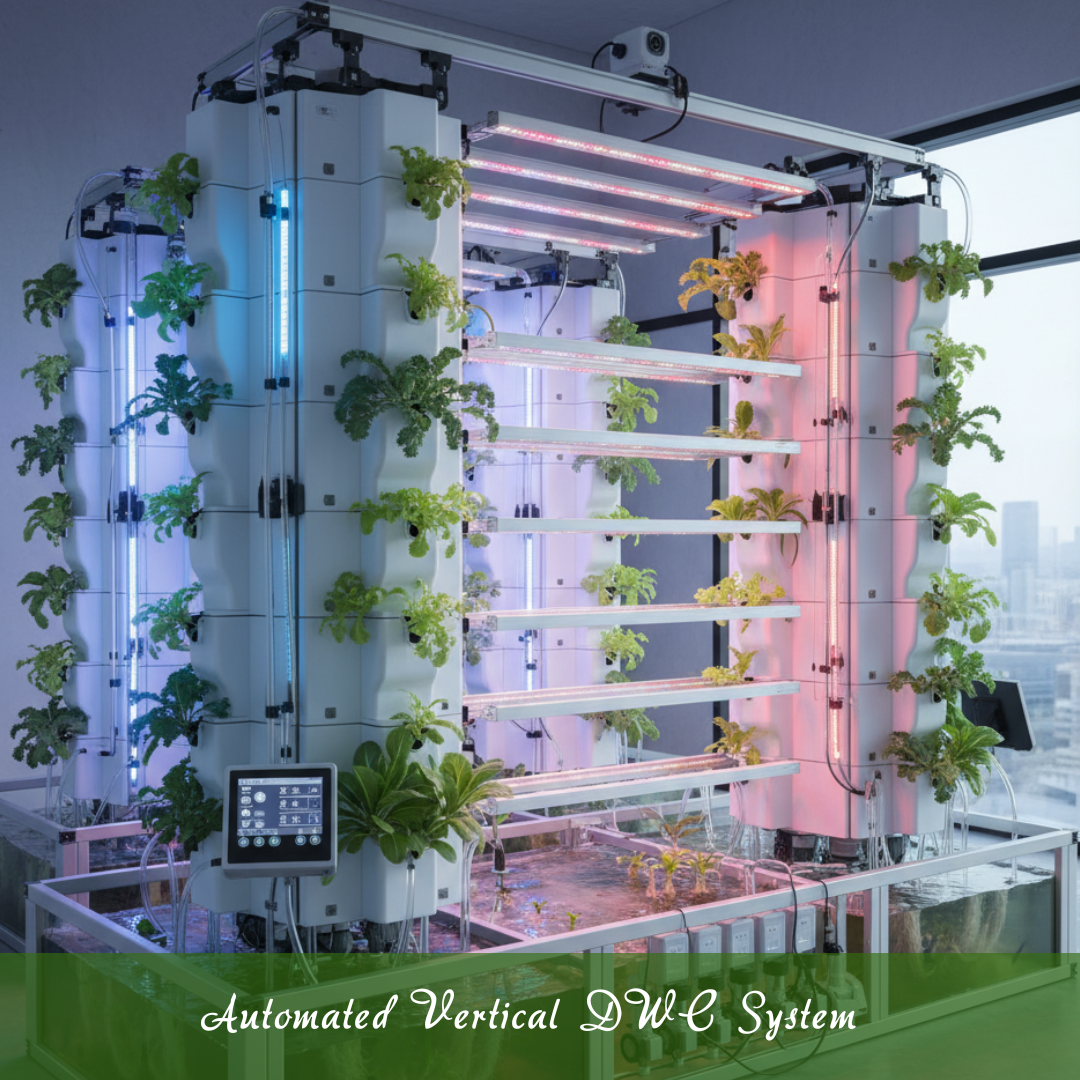
10. DWC Raft System
The DWC raft system uses floating rafts or boards to support plants, with roots suspended directly in nutrient solution below. It works best in controlled indoor environments or greenhouses, 65–80°F.
Prices vary from $200 to $1,500 based on the size of the raft and the configuration of the reservoir. In semi-commercial and recreational settings, this system is perfect for growing herbs and leafy greens.
Setup Process
To set up a DWC raft system, fill a reservoir with nutrient solution and install air stones to ensure continuous oxygenation. Place floating rafts or boards with pre-cut holes for net pots on the surface.
Insert seedlings into net pots and position them in the holes so roots hang directly into the solution. Adjust the water level to allow roots to remain submerged while leaving room for air exposure.
Maintain pH at 5.5–6.5 and monitor EC and water temperature daily. Ensure the reservoir is stable and accessible for harvesting, cleaning, and adding new seedlings to sustain continuous production.
Growing Process
Set up a reservoir with a nutrient solution and install air stones for oxygenation. Place floating rafts or boards with holes for net pots. Seedlings are placed in net pots, roots hanging directly into the water.
Maintain pH between 5and –6.5 and monitor EC daily. Water temperature should remain stable, ideally 65–75°F. Harvest leafy greens and herbs in 30–50 days.
New seedlings can be added to maintain continuous production. The floating design allows easy inspection and management of roots.
Best Crops
Lettuce, spinach, basil, arugula, cilantro, kale, mint
Pros
Raft systems provide excellent root oxygenation and consistent nutrient access. They are scalable, low-maintenance, and easy to monitor.
Plants grow uniformly, and harvesting is simple. Water and nutrient use are efficient, and the system is beginner-friendly, allowing growers to produce high yields with minimal effort.
Cons
Roots can become waterlogged if oxygenation fails. Not suitable for large fruiting crops. Pump or air stone failures can impact all plants.
Algae and nutrient accumulation can be avoided with regular cleaning and maintenance. Growth may be affected by temperature changes if they are not sufficiently managed.

Conclusion
In conclusion, DWC hydroponic systems provide an efficient, high-yield, and beginner-friendly way to grow fresh crops without soil.
From simple standard setups to advanced automated and vertical systems, there is a DWC option for every grower. By understanding the pros, cons, and step-by-step growing processes, growers can select the best system for their space, budget, and crop type.
With proper monitoring, oxygenation, and nutrient management, DWC ensures healthy roots, faster growth, and sustainable year-round production.
I trust you enjoyed this article on the DWC Hydroponic Systems: Transform Your Garden. Please stay tuned for more inspiring guides, helpful tips, and ideas to help you live closer to nature every day.
Take care!
— JeannetteZ
💬 Your Opinion Is Important To Me
Do you have thoughts, ideas, or questions? I’d love to hear from you. Please leave your comments below or email me directly at Jeannette@Close-To-Nature.org.
📚 More Nature-Inspired Reads
Explore more ways to connect with nature, nurture your pets, and live in harmony with the world around you 🌿

